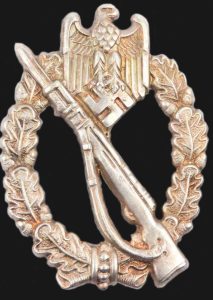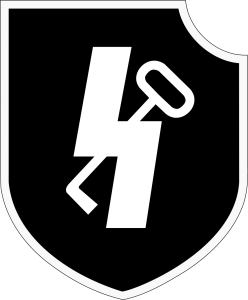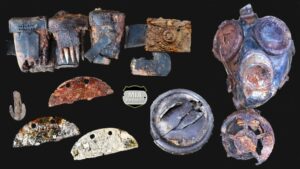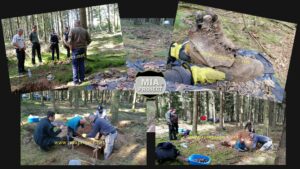Usually, our MIA related stories start with a historical background. This time, circumstances impose a more contemporary introduction.
We present and develop here the recovery of three German soldiers, all three recovered with legible dogtags, and about to be buried as unknown.
When asked why to the Volksbund Deutsche Kriegsgräberfursorge (German Army Military Grave Registration Service), our request was ignored. Their lack of response sounded like a dismissive kiss off. Although claiming to be doing everything in their power to identify their fallen soldiers, this very much feels like a final humiliation for these three men and their families.
September 2020 – Monschau Forest.
While conducting intensive research for a 99th Division serviceman still reported missing in action, our team discovered a common grave containing the remains of three German grenadiers. The three skeletons were uncomplete with extensive damages to the main bones and skulls. This suggested a sudden and particularly brutal death, and maybe an additional postmortem destruction by vehicle or artillery crushing. Fortunately, the three men still had their dogtags. More specifically each were still wearing a half dogtag.
German dogtags are made of a disk manufactured to be broken in two identical halfs. One remaining with the body and one going through the administration system. This suggests that the three bodies were treated, reported as KIA’s but due to the circumstances, buried on the battlefield in an unmarked grave. Administratively, they were reported « KIA’s – body not recovered ». Icing on the cake, a very meaningful butterdish engraved with « HE » was recovered and undoubtedly adding an important detail for a possible identification.
After the usual administrative procedures with the forest department and the police, osseous remains, dogtags and equipment were handed over to the mortuary affairs of the Belgian Army. They brought remains and equipment to their office in Langemark, Belgium, and started the administrative procedure with the local office of the Volksbund DeutscheKriegsgräberfürsorge (German Army MortuaryService).
Months passed, then years. Despite repeated requests to the Belgian branch of the VDK, no identification took place, no follow up information was shared. The boxes containing the bones still gathering dust on their shelf in Langemark. With insistence, a final request was sent in the spring of 2024 to the Belgian branch of the VDK, we learned with disbelief that:
“… specialists of the Volksbund Deutsche Kriegsgräberfürsorge came to examine the bones in March 2024 but there was unfortunately no positive identification. Their burial as unknowns will take place in Lommel in 2025 ».
Administration is known to be slow but four years just to take the lift down to the archives and search some dusty files, does it sound respectful?
Other questions surface. Three half dogtags were found, meaning that the three men were officially reported as KIA’s but their bodies never recovered. So a search in the KIA listing of the Regiment with the dogtags’ references appears to be an easy task to find a match. Additional and important detail to ease identification was the discovery of a butterdish engraved « HE ». Why a visit to Belgium to examine remains when the answer is in the archives in Germany? How a visual examination of remains could lead to a negative or positive identification? This type of work is only performed in a fully equiped laboratory by anthropologists… Is there a need for such “specialists” or is it just a lack of will?
This is how all started.
Krinkelt Forest – 0930, December 17, 1944.
The battle was raging in the Dreiherrenwald for nearly 24 hours when the leading element of the II./SS PzGren Regt 25 reached the beginning of Rollbahn A (route A).
Rollbahn A, a muddy forest lane, was the northernmost penetration route assigned to the
I. SS Panzer Korps for its drive to the Meuse River. On the German battle map, Rollbahn A was the objective of VolksGrenadier Regiment 989 of the 277. Volksgrenadier Division on December 16, 1944. Their mission was to breach through the American lines, opening the road on about 3 miles in the forest and then onto the village of Rocherath. An armored column of the 12.SS Panzer Division would follow and exploit the breakthrough towards Elsenborn and to the West.
According to the plan, the VGR 989 had stormed the American front hold by the 99th Division, most specifically the 3rd Battalion of the 393rd Infantry, and pushed them back on about one mile. At the end of the day, however, gains were not as expected. The American resistance was much bitter than previously expected and the Germans were stalled halfway in the forest. The next day, December 17, the 3rd Bn of the 393rd Infantry was just about starting to counterattack to restore its lines when the 12.SS Panzer Division was committed to help breaching through the forest. The lead unit was II./SS Panzergrenadier Regiment 25, commanded by SS-Obersturmbannführer (SS-LtCol) Richard Schulze-Kossens, reinforced by a platoon of assault guns (Pz IV/70) of the SS-Panzerjäger Abt. 12 and a platoon of anti-aircraft guns mounted on halftracks.
SS-Sturmmann (SS Corporal) Wolfgang Zapf : “… We detrucked 500m west of Hellenthal on December 16, at about 17:00.We already received artillery fire and suffered a few losses. We stayed in that vicinity overnight and started our advance the next morning … We reached the Westwall shortly before noon and we could hear the noise of the battle … My battalion, the 2nd Battalion, was leading the attack … and I, myself, was not with the most forward elements. When we started the attack, my company, the 6. Kompanie, was 120 men strong but we had almost 80% losses during the fighting in the woods. Most of our men were 17 or 18 years of age and just got regular infantry training. In the attack we used three self-propelled guns which proceeded on the road…”
SS-OStubaF Schulze started out his battalion to the right of Rollbahn A since the forest lane was barely passable due to abandoned equipment and mud. The 7. Kompanie at the point, SS Grenadiers advanced downhill toward the Olef creek then up hill on the reverse slope until they smacked into the men of the 3/393.
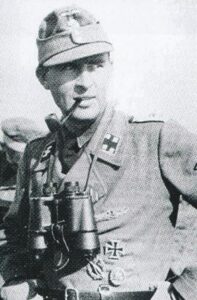 SS-OStubF Schulze : “… since the men were largely without combat experience, only the deployment of the officers in the front lines could help. In the first hours, all Kompanie Chiefs were lost, either killed or wounded… I remember the very difficult crossing of the Jans creek so well because almost at the creek, I came under fire from snipers. I pretended to have been killed and, after some considerable time, I suddenly leaped up and into cover. The continuation of the attack, swinging further south … led to success.
SS-OStubF Schulze : “… since the men were largely without combat experience, only the deployment of the officers in the front lines could help. In the first hours, all Kompanie Chiefs were lost, either killed or wounded… I remember the very difficult crossing of the Jans creek so well because almost at the creek, I came under fire from snipers. I pretended to have been killed and, after some considerable time, I suddenly leaped up and into cover. The continuation of the attack, swinging further south … led to success.
SS-Untersturmführer (SS 2Lt) Ernst Stuhr (7.Kp/SS-PzGren Regt 25) was also present:
“… My Kompanie moved forward, widely dispersed. To the left of the forest lane was my I.Zug (note: 1st Platoon) to the right the II. Zug. I spotted our Battalion Commander Schulze standing upright at the side of the lane looking through his binoculars … after moving into the woods, we encountered stragglers of the Heer (note: Regular Army) they were asked to join us. Our attack initially progressed well. The fighting spirit of the men was excellent…”
The combat turned into a wild, brutal and merciless melee with hand to hand and grenade fightings. Atop the hill, Company L, 393rd Infantry was covering both sides of trail and was heavily engaged. S/Sgt Vernon McGarity’s squad and S/Sgt Molter’s took the brunt of the attack.
Pvt Edward W. Schuhardt: “… I could hear the Germans yelling and hollering like they were having a good time … “ Schuhardt looked off to the right at a swarm of SS Grenadiers coming at his position and raised his BAR. He continues “… they didn’t know we were there. They put down a tripod and were putting the gun on when I let them have it… A German came from my right side trying to hurl a grenade at me. I swung my BAR and dropped him on the trail. Others fired at him … until he stopped moving. His body was absolutely riddled…”
As SS Grenadiers were advancing uphill toward the perimeter of defense of the 3/393, the resistance stiffened. SS-UStuf Stuhr continues : “… Enemy resistance constantly increased. All sorts of shells were exploding around us, not only on the ground but also in the treetops. A messenger brought me the order to take over the Kompanie since our chief had been wounded…”
Soon after, SS-UStuf Stuhr was wounded multiple times by schrapnels and rifle fire in the arm, back and leg. He was evacuated and only regained consciousness in the hospital train. His leg was later amputated.
Among the self propelled guns, actually Panzer IV/70 of the SS Panzerjäger Abt 12, were tank commander SS-UScha (SS Sgt) Hans Baumann and platoon leader SS-UStuf (SS 2Lt) Helmuth Zeiner. Both members of the 1./SS PzJg Abt 12 and both remembering the mercyless fighting in the forest.
SS-UStuf Zeiner recalls: “… We followed a narrow, occasionally winding forest lane when it split and 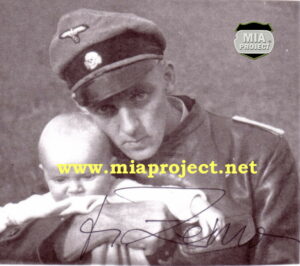 dropped off. There all hell broke loose. The enemy had armor piercing weapons, snipers in the trees and a few Sherman tanks. SS-Oscha (SS S/Sgt) Roy who had taken the I. Zug in my place was driving behind me. He was killed by a shot in the head. Roy had been awarded the Knight Cross during the invasion. He was a likable young lad with a lot of skill and courage. The death of our comrade provoked a great rage in us all and I drove recklessly. I overtook an American anti tank position and we fired explosive shells as well as our turret twin MG to the right and left at the fleeing enemy..”.
dropped off. There all hell broke loose. The enemy had armor piercing weapons, snipers in the trees and a few Sherman tanks. SS-Oscha (SS S/Sgt) Roy who had taken the I. Zug in my place was driving behind me. He was killed by a shot in the head. Roy had been awarded the Knight Cross during the invasion. He was a likable young lad with a lot of skill and courage. The death of our comrade provoked a great rage in us all and I drove recklessly. I overtook an American anti tank position and we fired explosive shells as well as our turret twin MG to the right and left at the fleeing enemy..”.
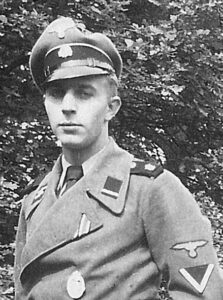 SS-Uscha Hans Baumann: “… After Hollerath, we turned right into the protective cover of the forest…when we arrived [our] infantry was already in the heat of close combat. We proceeded on the forest trail following the infantry. Out tank could barely follow the narrow lane. Suddenly we arrived at a small path on the right and there were three dead comrades laying in the mud. There was no room to the right or left and we had to pass on them. This left me with a really bad feeling…”.
SS-Uscha Hans Baumann: “… After Hollerath, we turned right into the protective cover of the forest…when we arrived [our] infantry was already in the heat of close combat. We proceeded on the forest trail following the infantry. Out tank could barely follow the narrow lane. Suddenly we arrived at a small path on the right and there were three dead comrades laying in the mud. There was no room to the right or left and we had to pass on them. This left me with a really bad feeling…”.
Atop the hill, about 400 yards south-east of Rollbahn A, activity was intense in the positions of the heavy mortars of Company M, 393rd Infantry. The six 81mm tubes had fired nearly 3000 rounds to the front since the beginning of the battle. They soon received the order to fire backwards with minimum propelling charge.
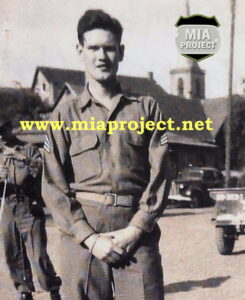 PFC Earl Wiseman, mortarman with Co M recalls : “… We had a light MG at the left front of our area blazing away. Targets began to pour in over our radio and here I go with the map, protractor and range scale, plastering everything from the draw to the wooded area. One section was giving hell to the front and the others firing across the road to the left, swinging one gun here, laying another there, shifting distances and ranges steadily decreasing until they were down to 50 yards … firing nearly straight up to put them right on top of Jerry coming thru those woods…”.
PFC Earl Wiseman, mortarman with Co M recalls : “… We had a light MG at the left front of our area blazing away. Targets began to pour in over our radio and here I go with the map, protractor and range scale, plastering everything from the draw to the wooded area. One section was giving hell to the front and the others firing across the road to the left, swinging one gun here, laying another there, shifting distances and ranges steadily decreasing until they were down to 50 yards … firing nearly straight up to put them right on top of Jerry coming thru those woods…”.
In the late morning, under the increasing German pressure, the American perimeter of defense started to crack. Individuals or entire sections started to fall back to the battalion command post. The heavy mortarmen of Co M in direct contact with the enemy abandonned their positions. There was nothing they could do, they had fired all their ammunition in the valley and in the forest, altogether 3000 rounds. At about noon, LtCol Jack G. Allen, commanding the 3rd Battalion of the 393rd Infantry received the order to abandon his positions in the forest and withdraw to Krinkelt and beyond to the Elsenborn Ridge. At 13:30 withdrawal was completed and the hill was in the hands of the Panzergrenadiers of SS-OStubaF Schulze-Kossens. They had succeeded to force the Americans to withdraw but the cost in human life was terrible. The forest floor was covered with equipment and dead bodies. And they were only half way through.
It took SS-OStubaf Schulze-Kossens another six hours to pass through the 3rd Battalion of the 23rd Infantry sent in emergency to back off LtCol Allen’s 3/393. By 18:00, SS Grenadiers and armor had reached the western edge of the forest. They were one full day beyond schedule and still not in the village of Krinkelt-Rocherath. Halfway to the village was the 1st Battalion of the 9th Infantry Regiment and, in the village itself, the 38th Infantry Regiment waiting for them. Read more about the 1st Bn, 9th Infantry here: http://www.miaproject.net/battlefield-relics-memorabilia/battlefield-relics/hold-at-all-costs/
January 2025.
At the time of this writing, three months after our last attempt to contact the Volksbund Deutsche Kriegsgräberfursorge, the German War Grave Administration, to request specific information regarding the burial as unknown, we still have not heard back from them. We will probably never but our motivation to put a name on those remains remains intact.
Sources :
MIA Project collections : Interviews with Helmuth Zeiner, Earl Wiseman, Edward Schuhardt, After Action Report 3/393.
NARA declassified interview of Wolfgang Zampf (1945)
The story of the Hitlerjugend (Hubert Meyer)
Hans Baumann : Mein Einsatz als Panzerjäger

